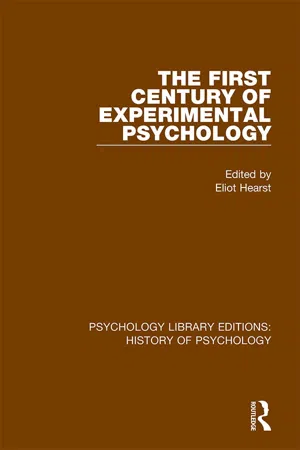Psychology
Ethology
Ethology is the scientific study of animal behavior, focusing on natural environments and evolutionary perspectives. It seeks to understand the adaptive significance of behaviors and how they contribute to an organism's survival and reproduction. Ethologists often use observational and comparative methods to study behavior across different species and environments.
Written by Perlego with AI-assistance
6 Key excerpts on "Ethology"
Learn about this page
Index pages curate the most relevant extracts from our library of academic textbooks. They’ve been created using an in-house natural language model (NLM), each adding context and meaning to key research topics.
- eBook - ePub
- Rajesh Jani(Author)
- 2021(Publication Date)
- CRC Press(Publisher)
CHAPTER 5 Ethology-ANIMAL BEHAVIOURA nimal behaviour, Ethology or animal psychology is a branch of zoology deals with eaction and activities of the animal in its natural environment. It is a fascinating subject which has attracted the attention of biologists. Observations were made by the animal behaviourists on their learning abilities, intelligence etc. Study of animal behaviour is a complex subject difficult to interpret unless efforts are made to understand its meaning in relation to other species, particularly man. Nevertheless, differences in the consciousness of mind among animals and man render the subject more complicated. Animal behaviour is part of biology and is composed of physiology, psychology and sociology and these subjects are an integral part of ecology. Animal behaviour is response to the stimuli the animal receives from the environ-ment and is based on the interpretation of the motives of human mind which is called anthropomorphism (attribution of human qualities like motives and emotions to the behaviour of animals) and is not free from errors. It is suggested that animal behaviour may be studied without regard for mental evolution of man as the animals do not behave in the same manner as human beings.Ethology thus forms an important speciality for wildlife veteri-narians, for proper health management and care. Greek and early Darwinian biologists who studied develop-ment of instinct and intelligence among animals were unable to answer questions such as, do animals have souls? do animals reason? Have animal sensation? do animals have memory?do animal dreams? do animal counter act with human behaviour etc.Detailed synthesis on Ethology and psychology on tne behaviour of animals has been reviewed with over 400 cross references for detailed specific reading. Only a few aspects are discussed herein for basic understanding of the major parameters. - eBook - ePub
Theory in Social and Cultural Anthropology
An Encyclopedia
- R. Jon McGee, Richard L. Warms(Authors)
- 2013(Publication Date)
- SAGE Publications, Inc(Publisher)
Today, scholars with different scientific backgrounds continue to contribute to the understanding of the manifold aspects of human behavior from an evolutionary viewpoint. Evolutionary theory unifies them and thus creates a metadiscipline. The strength of this discipline is at the same time its greatest weakness: Evolution creates a common ground and forms a theoretical basis on which to build a research field, but at the same time, the multitude of disciplines that engage in ethological research have different histories and often use different methodological approaches. For example, evolutionary psychology and Ethology base their research on evolutionary theory; both investigate human behavior in a broad sense. But in the European tradition, human Ethology descended from Ethology as a biological discipline, while in the United States the psychological disciplines were the first to apply evolutionary theory to behavior-related questions. In human Ethology, observing behavior is central. In evolutionary psychology, the emphasis lies more on using questionnaires to conduct research.Additionally, these approaches may alienate scholars who are not open to evolutionary ideas. This is especially true when the research topic is humans and even more so where human behavior is concerned. Bill Charlesworth wrote that his biological approach to the study of children was not welcomed warmly by his colleagues, while the use of animal models was state of the art.Origins and Methods
Human Ethology draws its inspiration from Ethology, both in methodological and in theoretical respects. The great ethologist Nikolaas Tinbergen developed four questions that guide ethological research today. These questions illustrate a fundamental perspective of Ethology, that is, it integrates evolutionary knowledge with interspecific comparisons, endocrinology, and neurology as well as developmental biology to create a whole picture of behavior. Tinbergen asked the following questions:- What is the evolutionary function of a behavior, that is, its adaptive value?
- How did this behavior evolve in phylogeny?
- What are the proximate causes for the behavior, that is, the underlying brain functions, hormones, and so on?
- How does this behavior develop during ontogeny, that is, how do genes interact with the environment to manifest it in the organism?
Human Ethology approaches behavior from three complementary angles: observations of behavior in real-life settings, experiments, and behavior simulation. Observation of behavior in real-life settings is the most basic method, with the advantage that the behavior occurs unencumbered by experimental devices or experimenter and observer effects. The great shortcoming of this approach is that in natural settings the number of intervening variables is large and cannot be controlled. The only way to circumvent this problem is having large data sets, which it is difficult and time-consuming to collect. In the early days of human Ethology, in the search for universals in human behavior, observation in natural settings was the method of choice. Early ethologists, such as Rudolf Pöch or Irenäus Eibl-Eibesfeldt, employed special cameras to film behavior without their subjects being aware of it. Certainly, data collected this way do not meet the ethical standards for working with humans delineated in the Helsinki protocol. Nowadays, cameras have become much smaller and almost noiseless, so hiding them is not a great issue, but subjects have to provide informed consent before they can be filmed. - eBook - ePub
- John Bowlby(Author)
- 2012(Publication Date)
- Routledge(Publisher)
As one who strives to be both a clinician and a scientist I have been acutely alive to this conflict. As a clinician I have found Freud’s approach the more rewarding; not only has he drawn attention to psychological processes of immediate clinical relevance, but his series of concepts invoking a dynamic unconscious has been a practically useful way of ordering the data. Yet as a scientist I have felt uneasy about the unreliable status of many of our observations, the obscurity of many of our hypotheses and, above all, the absence of any tradition which demands that hypotheses be tested. To these defects are due I believe the controversies, too often both heated and barren, which have characterized psychoanalytic history. How, I have asked with many of my colleagues, can we subject psychoanalysis to greater scientific discipline without sacrificing its unique contributions?It was in this frame of mind that a few years ago I came across the work of the ethologists. I was at once excited. Here was a body of biologists studying the behaviour of wild animals who were not only using concepts, such as instinct, conflict, and defence mechanism, extraordinarily like those which are used in one’s day-to-day clinical work, but who made beautifully detailed descriptions of behaviour and had devised an experimental technique to subject their hypotheses to test. Today, I remain as impressed as I was then. Ethology, I believe, is studying the relevant phenomena in a scientific way. In so far as it studies the development of social behaviour, and especially the development of family relationships in lower species, I believe it to be studying behaviour analogous, and perhaps sometimes even homologous, with much of what concerns us clinically; in so far as it is using field description, hypotheses with operationally defined concepts and experiment, it is using a rigorous scientific method. True, only after it has been tried in the crucible of research endeavour shall we know whether it will prove as fruitful an approach with humans as it has with lower species. Suffice it to say that it is an approach which commends itself most warmly to me because I believe it can provide the range of concepts and data which are needed if the data and insights contributed by other approaches, notably those of psychoanalysis, learning theory and Piaget, are each to be exploited and integrated. - eBook - ePub
Neuroscience, Psychology, and Religion
Illusions, Delusions, and Realities about Human Nature
- Malcolm Jeeves, Warren, Jr. Brown(Authors)
- 2009(Publication Date)
- Templeton Press(Publisher)
Accordingly, it presumes that natural selection favored genes that engendered our ancestor with behaviors and brain-processing systems that solved survival problems, thus contributing to the spread of their genes. In 1992, John Tooby and Leda Cosmides defined evolutionary psychology as “psychology informed by the fact that the inherited structure of the human mind is a product of evolutionary processes.” 2 Thus, the main focus of research in evolutionary psychology is the question of how humans came to be the special animal that we seem to be. According to evolutionary psychologist Richard Byrne, some of the central questions in this field are: When did a particular cognitive trait enter the human lineage? What was the trait’s original adaptive function? Has it been retained for the same reason, or is it now valuable for some different purpose? Furthermore, what is the cognitive basis for the behavioral trait, and how does its organization relate to other mental capacities? 3 In discussions of comparative and evolutionary psychology, anthropomorphism figures large. As a result, popular reporting easily gives the impression that it is unproblematic to interpret the behavior of animals closest to us on the evolutionary scale based on our human experience. Frans de Waal comments: This use of anthropomorphism as a means to get at the truth, rather than an end in itself, sets its use in science apart from use by the lay person…. The ultimate goal of the scientist is emphatically not to arrive at the most satisfactory projection of human feelings onto the animal, but rather at testable ideas and replicable observations - eBook - ePub
- Elliot Hearst, Eliot Hearst(Authors)
- 2019(Publication Date)
- Routledge(Publisher)
If the doctrine of Evolution is true, the inevitable implication is that Mind can be understood only by observing how Mind is evolved. If creatures of the most elevated kinds have reached those highly integrated, very definite, and extremely heterogeneous organizations they possess, through modifications upon modifications accumulated during an immeasurable past—if the developed nervous systems of such creatures have gained their complex structures and functions little by little; then, necessarily, the involved forms of consciousness which are the correlative of these complex structures and functions must have arisen by degrees. And as it is impossible truly to comprehend the organization of the body in general, or of the nervous system in particular, without tracing its successive stages of complication; so it must be impossible to comprehend mental organization without similarly tracing its stages [Spencer, 1886, pp. 291–292].Whatever we may think of the overblown language, the message loud if not entirely clear is behavioral and psychological discontinuity within the biological continuity of evolution; or, as it is (not widely) known today, the doctrine or concept of levels in the psychological capacities of animals (Schneirla, 1949). That conception, among other evolutionary concerns, is entirely lacking in modern associationism, although there are some signs of change in the offing (e.g., Hinde & Stevenson-Hinde, 1973; Seligman & Hager, 1972).IV. Ethology
If psychologists had remained faithful to their early intellectual tradition, in which biological thinking was central, there would have been no need and no place for the discipline of Ethology. Ethology came on the scene when most animal psychologists began to limit their study to only a few species under a narrow range of laboratory conditions, which were not designed with an eye toward the evolution or development of the species under study [e.g., see the critiques of Schneirla (1946) and Beach (1950)]. A second factor that fostered (nay, necessitated) the emergence of Ethology was the decline of the concept of instinct as a theoretical construct relating to the development and evolution of species-typical or species-specific behavior. William James (1890) listed dozens of human and animal instincts in his texts on general psychology; social psychology was founded on the concept of instinct (McDougall, 1908), with its intellectual tradition unmistakably derived from Darwin’s (1872) Expression of the Emotions in Man and Animals - Michael D. Breed(Author)
- 2017(Publication Date)
- Academic Press(Publisher)
Fig. 20.1 ).Figure 20.1 Major points of difference between comparative psychology and Ethology, as viewed from a perspective of the time when the divide was maximal. Certainly individual investigators on both sides of the fence diverged from the stereotypes expressed in this figure.The lasting remnant of the debate is an occasional cross-disciplinary lack of communication that sometimes slows scientific progress. For an example of this, see Chapter 61 , 1985 An Animal Model for Anxiety, and Chapter 63 , 1990 Fear; the two chapters represent the neuroscience and behavioral ecology, respectively, of the same topic. It is evident that the developers of these concepts have thought much too little about work that relates to their own findings but which seems disciplinarily distant.In general, too little has been done to integrate related concepts in neuroscience and behavioral ecology, even when the interactions between sets of findings seem clear. How much of this myopia is carryover from decades-old disputes is not clear, but going forward it is really time to find ways to synthesize interesting findings from diverse disciplines.Impact: 9
Because the debate between comparative psychologists and ethologists ultimately led to a lack of mutual respect for each others’ scientific findings, this chasm harmed progress in the search of knowledge. The sociobiology debacle prolonged the damage, as only now are behavioral ecologists finding ways to merge their findings with contemporary neuroscience.References and Suggested Reading
1. Dewsbury DA. Comparative Psychology in the Twentieth Century Stroudsburg, Pennsylvania: Hutchinson Ross Publishing Company; 1984;413.2. Lehrman DS. A critique of Konrad Lorenz’s theory of instinctive behavior. Q Rev Biol. 1953;28:337–363.3. Rosenblatt JS. Daniel Sanford Lehrman June 1, 1919–August 27, 1972





